《语言学教程》chapter_3_Morphology
- 格式:ppt
- 大小:2.08 MB
- 文档页数:32
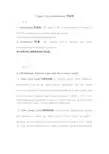
Chapter Three Morphology形态学一、定义1. Morphology形态学:t he study of the internal structure of words (内部研究), and the rules by which words are formed.对单词的内部结构和单词构成规则的研究。
2. Morpheme 词素:The smallest unit of language that carries information about meaning or function.最小的语言单位,携带信息的意义或功能。
二、知识点3.2 Distinctions between open and close classes word1. Open class words开放性词类: In English, nouns, verbs, adjectives, and adverbs make up the largest part of vocabulary. They are content words of a language.,which are sometimes called open class words, since new words can be added to these classes regularly. 在英语中,名词、动词、形容词和副词占词汇的绝大部分。
他们是一门语言中的实义词,由于我们经常可以在这类词中加入新词,所以他们有时也称开放性词类。
2. Close classes word封闭性词类:Conjunctions, prepositions, articles and pronouns is small and stable since few new words are added , therefore such words have been referred to as closed class words. 构成连词、介词、冠词和代词的词相对较少,通常不添加新词,所以被称为封闭性词类。
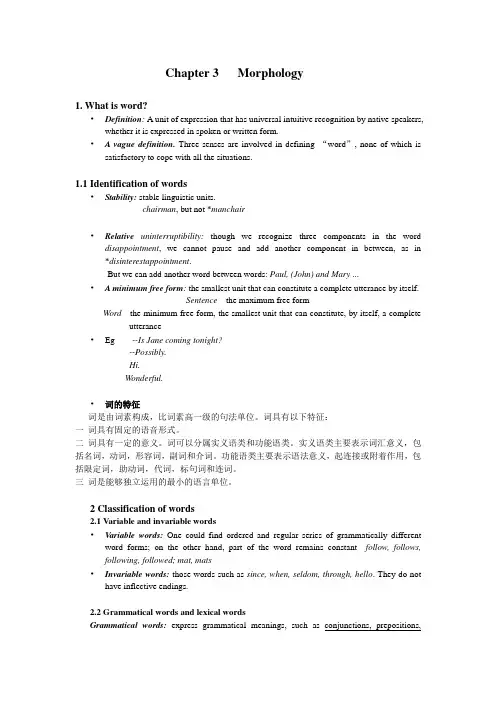
Chapter 3 Morphology1. What is word?•Definition: A unit of expression that has universal intuitive recognition by native speakers, whether it is expressed in spoken or written form.• A vague definition.Three senses are involved in defining “word”, none of which is satisfactory to cope with all the situations.1.1 Identification of words•Stability:stable linguistic units.chairman, but not *manchair•Relative uninterruptibility:though we recognize three components in the word disappointment, we cannot pause and add another component in between, as in *disinterestappointment.But we can add another word between words: Paul, (John) and Mary ...• A minimum free form: the smallest unit that can constitute a complete utterance by itself.Sentence---the maximum free formWord---the minimum free form, the smallest unit that can constitute, by itself, a complete utterance•Eg --Is Jane coming tonight?--Possibly.Hi.Wonderful.•词的特征词是由词素构成,比词素高一级的句法单位。
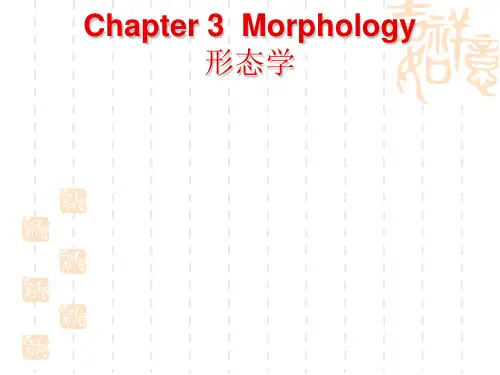
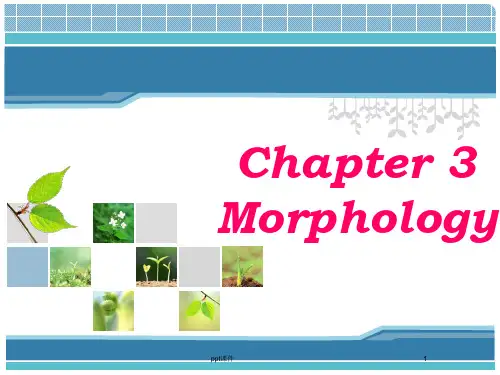
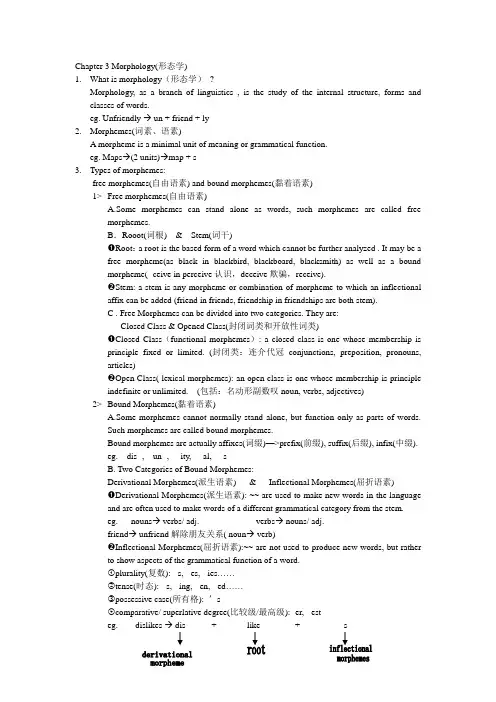
Chapter 3 Morphology(形态学)1.What is morphology(形态学)?Morphology, as a branch of linguistics , is the study of the internal structure, forms and classes of words.eg. Unfriendly → un + friend + ly2.Morphemes(词素、语素)A morpheme is a minimal unit of meaning or grammatical function.eg. Maps→(2 units)→map + s3.Types of morphemes:free morphemes(自由语素) and bound morphemes(黏着语素)1>Free morphemes(自由语素)A.Some morphemes can stand alone as words, such morphemes are called freemorphemes.B.Rooot(词根) & Stem(词干)❶Root:a root is the based form of a word which cannot be further analyzed . It may be a free morpheme(as black in blackbird, blackboard, blacksmith) as well as a bound morpheme( -ceive in perceive认识,deceive欺骗,receive).❷Stem: a stem is any morpheme or combination of morpheme to which an inflectional affix can be added (friend in friends, friendship in friendships are both stem).C . Free Morphemes can be divided into two categories. They are:Closed Class & Opened Class(封闭词类和开放性词类)❶Closed Class(functional morphemes): a closed class is one whose membership is principle fixed or limited. (封闭类:连介代冠conjunctions, preposition, pronouns, articles)❷Open Class( lexical morphemes): an open class is one whose membership is principle indefinite or unlimited. (包括:名动形副数叹noun, verbs, adjectives)2>Bound Morphemes(黏着语素)A.Some morphemes cannot normally stand alone, but function only as parts of words.Such morphemes are called bound morphemes.Bound morphemes are actually affixes(词缀)—>prefix(前缀), suffix(后缀), infix(中缀).eg. dis- , un- , -ity, -al, -sB. Two Categories of Bound Morphemes:Derivational Morphemes(派生语素) & Inflectional Morphemes(屈折语素)❶Derivational Morphemes(派生语素): ~~ are used to make new words in the language and are often used to make words of a different grammatical category from the stem.eg. nouns→ verbs/ adj. verbs→ nouns/ adj.friend→ unfriend解除朋友关系( noun→ verb)❷Inflectional Morphemes(屈折语素):~~ are not used to produce new words, but rather to show aspects of the grammatical function of a word.①plurality(复数): - s, - es, - ies……②tense(时态): - s, - ing, - en, - ed……③possessive case(所有格): ’s④comparative/ superlative degree(比较级/最高级): -er, - esteg. dislikes → dis + +3> free morphemes(自由语素) & bound morphemes(黏着语素)❶All monomorphemic(单词素/单语素) words are free morphemes;❷These polymorphemic words are either compounds( combination of two or more free morphemes) or derivatives(words derived from free morphemes).4.Morphs(形素) and Allomorphs(语素变体)Morphs: the phonological and orthographic forms which realize morphemes are termed ― morphs‖.(语素的语音及对应拼写法的体现叫形素)Most morphemesSome morphemesAllomorphs: an allomorph is any of the different form of the same morpheme( 语素变体是同一个语素的不同形式).eg. plurality ―- s‖: map→ maps; dog→ dogs; class→ classed; mouse→ mice; sheep→ sheep Complementary distribution(互补分布):allomorph is a member of a set of morph;allomorph can’ t occur in the same environment .5> Types of Word Formation(构词法)❶Compounding(合成法)Words are formed by putting two words together, this way of building new words is called compounding.❷Derivation(派生法)Derivation is done by adding affixes to other words or morphemes.❸Conversion(转换法)Many words have more than one part of speech. A noun can become a verb easily and a verb can be used as a noun.❹Backformation(逆向构词法)As we have editor, we get edit by dropping – or . This process is called ~~❺Clipping(截短法)This process by cutting off part of word is called ~~❻Blending(混合法)A single new word can also be formed by combining two separate forms, this process iscalled ~~~❼Acronymization(缩略法)。
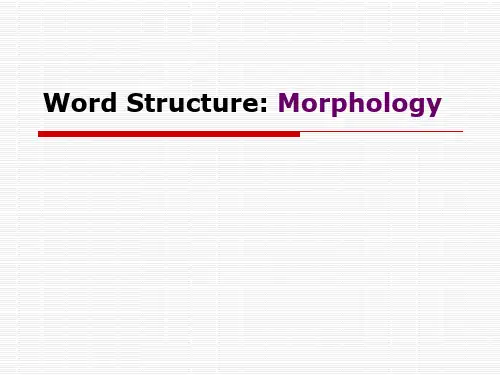
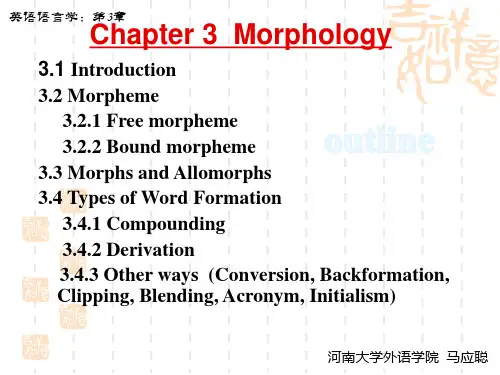
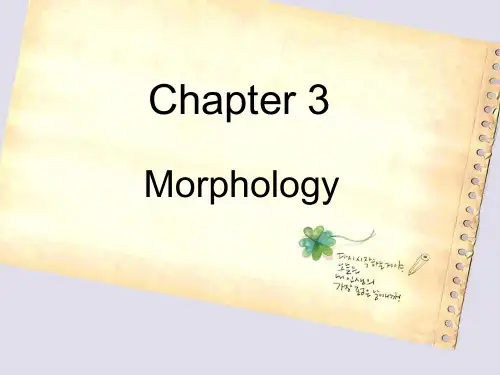
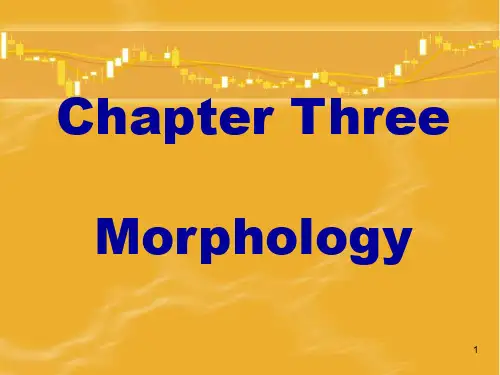
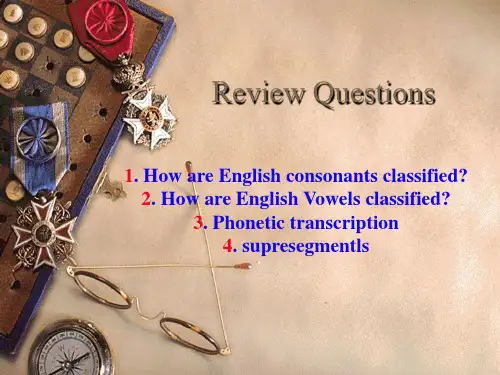

Chapter 3 Morphology 形态学1.Definition 定义Morphology is a branch of grammar which studies the internal structure of words and the rules by which words are formed.形态学是语法学的一个分支,它研究的是单词的内在结构及单词的构成规则。
The aim of morphology is to find out these rules。
形态学的任务就是要找出这些规则(单词构成的规则)。
Morphology is divided into two sub-branches:inflectional morphology and lexical or derivational morphology. The former studies the inflections and the latter the study of word-formation.形态学可以划分两个分支:屈折形态学和词汇形态学(也叫派生形态学).前者研究的是单词的屈折变化,后者研究的是构词法。
2.Morpheme 词素2.1Morpheme: the smallest meaningful unit of language词素:语言中最小的意义单位Just as a phoneme is the basic unit in the study of phonology, so is a morpheme the basic unit in the study of morphology。
正如音位是音系学研究中的基本单位一样,词素是形态学研究中的基本单位。
Monomorphemic words 单词素单词2.2Types of morphemes 词素的类型2.2.1Free morphemes 自由词素The morphemes that are independent units of meaning and can be used freely all by themselves are called free morphemes。
戴炜栋语言学-Chapter 3 Morphology●开放类和封闭类Open class and closed class●开放性词类(open class words):名词、动词、副词和形容词●封闭性词类(closed words):连词、介词、冠词、代词●词素Morphemes---the minimal units of the meaning●词素的定义the definition●词素morpheme--带着信息和功能的语言的最小单位 a morpheme can be definedas.a minimal unit of meaning.例如:reader是由read和er两个词素组成 boys是由boy和-s两个词素●注意:●词素既不是意义,也不是音阶,而是意义和音阶的组合;●词素通常是任意的,他们的声音和意义之间没有必然的联系;●如果想区分词素之间的区别,可以使用语素(morph);●区分独立词和复杂词的区别:前者为单一词素构成,后者包括两个及以上的词素●词素的分类●自由和黏着词素(Free and bound morphemes)●自由词素:可以独立成词的词素成为自由词素 can be a word by itself●黏着词素:必须依附于另一个词素must be attracted to another one●同质异形体(Allomorphs)The variant forms of a morpheme are called its allomorphs.●Analyzing word structures分析词的结构●root词根 The roots constitutes the core of the word and carries the major component ofits meaning.●The roots typically belongs to a lexical category and are always bound morphemes.●affixes词缀 Affixes do not belong to a lexical category and are always bound morphemes ●Derivational and inflectional morphemes派生词素和曲折词素●派生词素:-en, -ate, and -ic are thus called derivational morphemes●曲折词素:there are bound morphemes which are for the most part of purelygrammatical markers and signify such concepts as tense, number, case and so on.●Morphological rules of word formation构词的形态学规则●词的构成方式被称为形态学规则(morphological rules),这些规则决定了词素怎样组合成为词。